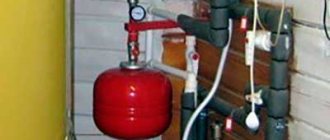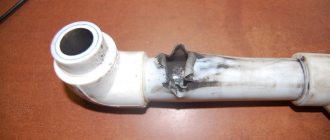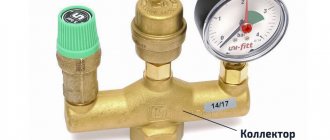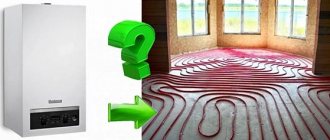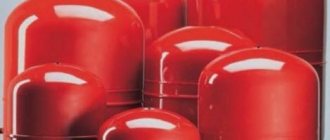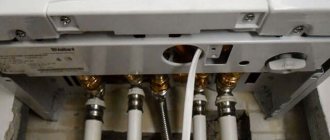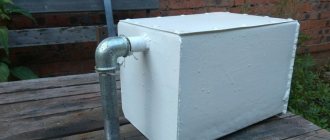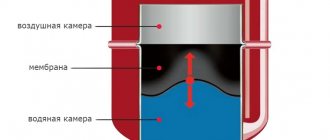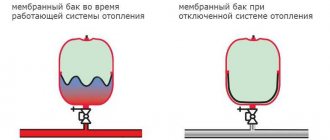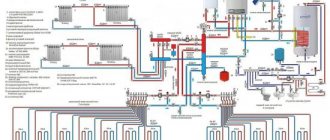Autonomous heating systems are very popular in suburban construction. Their creation allows the home owner to feel independent from utility services and significantly save on heating bills. Moreover, in some cases, connecting to the main heat supply system is simply impossible. In general terms, an individual heating system in a private house with liquid coolant consists of a device that heats water (it can operate on different types of fuel) and a hot coolant circulation system.
The design and construction of a water circulation system plays an important role in creating a high-quality autonomous heating system. It consists of several components, and among them the expansion tank for heating plays not the least role, if not the decisive one! For the full functioning of the system, the tank is simply necessary, it makes the system more holistic and without it functioning is impossible in principle! It's like a car that can only drive if all its components and assemblies are configured and functioning normally!
External view of the expansion tank for heating
Expansion tank installation process
Now let's figure out how to install an expansion tank in a heating system.
There is an important rule for connecting the device: the tank must be connected to the heating system main using a shut-off ball valve with an American connection. This installation principle makes it possible, if necessary, to shut off the flow of water in the system at any time, remove the faulty membrane tank and install a new one
Otherwise, you would have to wait for the coolant to cool down and dismantle part of the piping. Ideally, a tee is installed on the supply line, as well as a second tap - in this case, before removing the expansion tank, it can be emptied into a substitute container.
How to correctly orient a membrane expansion tank in space? The tank is installed with the air chamber up or down, and the container is placed “on its side”. From the point of view of operational characteristics, this does not matter much, since in any case the device will perform its functions properly.
However, it is worth considering this point: if the air compartment is located at the bottom, then the coolant is supplied from above, and the bubbles of air dissolved in it will rise into the pipeline and be removed using an air valve. Otherwise, an air bubble will form in the “water” compartment of the membrane tank over time.
In turn, when the tank is positioned with the air chamber upward, its service life is extended. Over time, from constant contact with hot water, the polymer membrane loses its tightness and cracks appear in it. If the air chamber is located at the bottom, then water will immediately begin to seep into the air compartment, which will quickly damage the expansion tank, while air will penetrate into the coolant. When the air chamber is located on top, the diffusion of water through cracks occurs many times slower, and the device can operate much longer.
- If you install a pressure gauge next to the expansion tank and the valve, thanks to which the heating system is fed from the water supply, it will allow you to control the pressure in the system in order to bleed off excess in time if the safety valve spool is stuck and does not operate automatically.
- Frequently repeated release of pressure by the valve indicates that the capacity of the expansion tank is selected incorrectly. Instead of changing it to a larger tank, just connect a second tank in parallel.
- Replacing the existing expansion tank with a larger one or connecting a second one will also be required if it is decided to replace the water in the system with antifreeze. This is due to the fact that non-freezing coolants have a higher coefficient of thermal expansion.
Before connecting the tank and filling it with coolant, you need to check the pressure level in the air chamber of the tank - it must correspond to the pressure in the heating system. For this purpose, you should remove or unscrew the plastic plug that covers the spool valve (similar to those installed in car cameras). Using a pressure gauge, it is necessary to measure the pressure and adjust it to the indicators of the heating system. To do this, air is pumped up by a pump or, vice versa, it is bleed by pressing the spool rod.
Note! The tank should be adjusted so that the pressure in its air chamber is 0.2 bar less than the design pressure in the system filled with coolant. If the pear-shaped membrane is not pressed on the water injection side, the coolant, compressing during the cooling process, will be able to draw in air through automatic air vents
After completing the settings, open the tap and fill the entire system with coolant. Then the boiler unit starts up.
The adjustment step is not required if the factory pressure in the air compartment of the expansion tank corresponds to the required parameters. Manufacturers of some brands of equipment indicate the pressure level in the tank on the packaging, which makes it possible to select the optimal option when purchasing.
Conclusion
You can correctly install the expansion tank and prepare the customized membrane tank for operation yourself, without the help of a specialist. The experience gained may be useful in the future if you need to quickly determine the source of problems associated with a decrease or surge in pressure in the system, due to which the burner flame goes out. In such cases, it is recommended that you first carefully inspect the system for coolant leaks and measure the pressure in the air chamber of the membrane reservoir.
The procedure and conditions for installing the tank
The membrane accumulator can be installed independently, without the involvement of a specialist. The list of requirements for installing the device is as follows:
- The device must not be installed in places with sub-zero temperatures;
- the expansion tank can be installed at any point in the heating system before it is branched;
- the fastening must be as reliable as possible, since a filled tank becomes very heavy;
- connections must be sealed, but sealants cannot be used, since they will worsen friction between the tank body and the membrane;
- Do not install the tank on the outlet pipe in the immediate vicinity of the heating boiler.
If the hydraulic accumulator capacity has a volume of 30 liters or more, it is prohibited from attaching it to supporting structures. Most often, such tanks are equipped with special legs, which allow them to be installed directly on the floor. During installation, the following conditions must be observed:
- the pipe must have a three-quarter (inch) circumference; accordingly, a similar threaded channel must be present in the return pipeline;
- any external load on the tank must be excluded;
- paronite gaskets that are resistant to high temperatures or pressure should be used;
- In order to regulate or maintain the required pressure in the gas compartment, the expansion tank must be equipped with an air valve.
When installing the hydraulic accumulator, gross mistakes must not be made, otherwise the equipment will not function normally. The most common mistake is incorrectly calculated maximum pressure (which is about 90% of the critical pressure) in the gas compartment. Such a miscalculation leads to the fact that the membrane does not expand and does not allow excess coolant to pass into the tank. The result will be a pipe break and failure of the heating system. A high-quality pressure gauge installed on the hydraulic accumulator protects against such developments. If after calculations it turns out that the volume of the existing tank is not enough, you will need to purchase an additional small container.
The expansion tank in the heating system is very important, since it determines how correctly the system will work. Installing it is not difficult, but it is necessary to carry out the entire process as carefully as possible, since even a small mistake can provoke an emergency. In a closed heating system, high pressure is constantly applied to the membrane; throughout the entire heating season, this device experiences serious loads. Therefore, at least once every 2 years you should check its condition and, if necessary, replace this part and/or the expansion tank itself.
How and where to install the expansion tank
So, we are going to design and assemble a heating system with our own hands. If it also starts working, our joy will know no bounds. Are there instructions for installing the expansion tank?
Open system
In this case, the answer will be prompted by simple common sense.
An open heating system is, in essence, one large vessel of complex shape with specific convection currents in it.
The installation of a boiler and heating devices in it, as well as the installation of pipelines, must ensure two things:
- Rapid rise of water heated by the boiler to the top point of the heating system and its drainage through the heating devices by gravity;
- Unhindered movement of air bubbles to where they will rush in any vessel with any liquid. Up.
- Installation of a heating expansion tank in an open system is always carried out at its highest point. Most often - at the top of the accelerating manifold of a single-pipe system. In the case of top-fill houses (although you hardly have to design them) - at the top filling point in the attic.
- The tank itself for an open system does not need shut-off valves, a rubber membrane, or even a lid (except to protect it from debris). This is a simple water tank open at the top, into which you can always add a bucket of water to replace the evaporated water. The price of such a product is equal to the cost of several welding electrodes and a square meter of steel sheet 3-4 millimeters thick.
This is what an expansion tank for an open heating system looks like. If desired, a water tap from the water supply can be brought into the hatch in it. But much more often, as the water evaporates, it is topped up with an ordinary bucket.
Closed system
Here both the choice of tank and its installation will have to be taken quite seriously.
Let's collect and systematize the basic information available on thematic resources.
Installation of the expansion tank of the heating system is optimal in the place where the water flow is closest to laminar, where there is a minimum of turbulence in the heating system. The most obvious solution is to place it in the direct filling area in front of the circulation pump. In this case, the height relative to the floor or boiler does not matter: the purpose of the tank is to compensate for thermal expansion and dampen water hammer, and we can bleed the air through the air valves.
Typical tank installation diagram. Its location in a single-pipe system will be the same - in front of the pump along the flow of water.
- Factory equipped tanks are sometimes equipped with a safety valve that relieves excess pressure. However, it is better to play it safe and make sure that your product has it. If not, buy one and install it next to the tank.
- Electric and gas boilers with electronic thermostats are often supplied with a built-in circulation pump and heating expansion tank. Before you go shopping, make sure you need them.
- The fundamental difference between membrane expansion tanks and those used in open systems is their orientation in space. Ideally, the coolant should enter the tank from above. This subtlety of installation is designed to completely remove air from the compartment of the tank that is intended for liquid.
- The minimum volume of the expansion tank for a water heating system is taken approximately equal to 1/10 of the volume of coolant in the system. More is acceptable. Less is dangerous. The volume of water in the heating system can be roughly calculated based on the thermal power of the boiler: as a rule, 15 liters of coolant per kilowatt is taken.
- A pressure gauge mounted next to the expansion tank and the feed valve (connecting the heating to the water supply) can provide you with an invaluable service. The situation with a stuck safety valve spool, alas, is not so rare.
- If the valve releases pressure too often, this is a clear sign that you have miscalculated the volume of the expansion tank. There is no need to change it at all. It is enough to purchase another one and connect it in parallel.
- Water has a relatively low coefficient of thermal expansion. If you switch from it to a non-freezing coolant (for example, ethylene glycol), you will again need to increase the volume of the expansion tank or install an additional one.
The expansion tank in the photo is installed according to all the rules: the coolant is supplied from above, the tank is equipped with a pressure gauge and a safety valve.
Requirements and recommendations for installing a membrane tank
Small volume tanks are mounted on the wall.
You can install the equipment yourself, following the instructions. When working, adhere to the installation requirements:
- The first stage is choosing a location. It is necessary to ensure free access to the tank for maintenance. A good place is considered to be the section of the return line between the pump and the boiler.
- To ensure the safety of a closed circuit, you will need to install a safety valve, an air vent, a pressure gauge and a thermometer.
- A drain valve is installed in front of the inlet pipe to drain water from the tank.
- Filters must not be installed in the area connecting the tank and the heating system.
- Before connecting the equipment, check the pressure of the gas space. If necessary, pump up air.
- The tank should not be located in a room with sub-zero temperatures.
The tank is securely mounted on the wall, and no additional load should be placed on it. Large volume models are mounted on the floor. A connection diagram with the inlet pipe located at the bottom is recommended. Experts advise making a detachable connection between the pipe and the drain valve in front of it. If necessary, the expansion tank can be easily dismantled.
The manufacturer specifies the requirements for the amount of antifreeze in the coolant. The stated proportions must not be exceeded.
Let's compare closed and open heating systems
The operation of an open heating system is based on the laws of thermodynamics, due to which the coolant moves. From an area of high pressure and corresponding temperature at the boiler outlet, water moves through pipes to an area of lower pressure, and its temperature decreases. The cooled coolant is sent back to the boiler and the process is repeated. Thus, natural circulation of liquid occurs, according to the laws of physics.
Since when water is heated, its volume increases, an expansion tank is provided in the design of an open heating system. For efficient movement of open-type coolant, the expansion tank is installed at the highest point of the system, and the heating boiler at the lowest. Installing an expansion tank in the attic seems to be the best option. Its device is not complicated.
Over time, water evaporates, so its level must be replenished in a timely manner. During breaks in the use of heating and at negative ambient temperatures, the water must be drained, otherwise it will freeze in the pipes and burst them. An open heating system has the following advantages:
- independence from electrical energy sources;
- no noise;
- ease of maintenance;
- quick start and stop.
You can select radiators for any type of heating system based on the recommendations of the article “Which radiators are best to choose for heating a private home: photos, dimensions and technical characteristics.”
In a closed heating system, water does not evaporate because it is sealed. The movement of the coolant is carried out using a pressure or circulation pump, which can be found in the article “Which circulation pump to choose for a water heating system for a private house, technical characteristics.” At the same time, for effective operation, an expansion tank made of durable metal is also required. A closed heating system consists of a heating boiler, a circulation pump, a pipeline network, radiators and an expansion tank. A closed heating system has the following advantages:
- no need to constantly monitor the coolant level;
- possibility of using antifreeze;
- internal pressure adjustment;
- possibility of connecting additional devices.
Closed heating system
With proper installation of heating equipment, both options will work perfectly. The choice between them is determined by operating conditions and placement features. The differences between the two systems are as follows:
In an open heating system, the expansion tank is located at the highest point. In a closed heating system it can be located almost anywhere. The likelihood of air locks forming in a closed heating system is much lower. This is due to increased internal pressure and lack of direct contact with the atmosphere. To operate an open heating system, large diameter pipes are required. Installation work is complicated by the need to take into account hydraulic rules when distributing flows, making turns, slopes, and so on. Small diameter pipes used in a closed heating system reduce its cost
Here it is important to correctly install the circulation pump so that during its operation it creates as little noise as possible.
Popular models
Expansion tanks of the Wester brand for hot water supply and heating are painted red.
The Russian brand Wester produces membrane tanks for cold and hot water supply, as well as heating. The WRV series is designed to compensate for the expansion of the coolant. It includes models of various capacities - from 8 to 10,000 liters. The body of the products is painted red.
Wester WRV 50
The device is used in closed heating systems. Its volume is 50 l. The housing is positioned vertically, installation is floor-mounted. The model is made from durable carbon steel. The membrane is made of food-grade synthetic rubber. It is replaceable; a flange on the neck of the tank allows you to install and fix a new elastic part. The design is designed for pressures up to 5 bar.
Wester WRV 200 top
Membrane tanks for heating Wester wrv200 top are made of complex drawn steel. Heat-resistant elastic EPDM rubber is used to separate the inner chamber. The part is replaceable. Operating temperature range from -10 to +100°C. The design can withstand pressure up to 10 bar, its volume is 200 liters. Floor placement.
The expansion tank is a simple in design, but functional part of the heating system. Prevents breakdowns caused by sudden increases in pressure. Its installation will ensure safe and stable operation of all working units.
general information
What is an expansion tank and what is it for?
Its very name gives a hint: for expansion. With a fixed mass of coolant in the heating circuit and pipes, the elasticity of which tends to zero, with a change in coolant temperature the pressure in the system will inevitably change. Thermal expansion, remember? Water or any other coolant expands when heated.
As soon as the force exceeds the tensile strength of the pipe or radiator... Boom!
The reason for a possible accident is that water, changing its volume when heated, remains practically incompressible. Hence the concept of water hammer: elastic interactions in a liquid medium, to put it simply, are absent.
The obvious solution is to create a reservoir in the system with an easily compressible substance - air. As the volume of water increases in the presence of such a reservoir, the pressure will increase slightly.
Useful: to prevent oxygen from the air tank from contributing to pipe corrosion by dissolving in water, in tanks for closed systems it is separated from the water by a rubber membrane.
This is what this simple device looks like in cross-section.
However, we have described only one of the functions of the expansion tank.
In addition to closed heating systems of private houses with fixed volumes of both the circuit and the coolant in it, an expansion tank can be found:
- In open systems in contact with atmospheric air;
- In central heating systems with top filling. There, the expansion tank is located in the attic and connects directly to the supply pipe of the house heating system.
In both described cases, installation of a heating expansion tank is necessary in order to get rid of air pockets. The difference between the two threads in the case of central heating is only about two meters. In heating systems of private houses with natural circulation - even less.
Clarification: the author can almost hear the exclamations of more or less knowledgeable people who, at the height of the heating season, saw a 10 times greater difference in the elevator unit. Typically 6 kgf/cm2 on the supply pipeline and 4 on the return pipeline (1 atmosphere of excess pressure corresponds to a water column of 10 meters). Do not confuse warm with soft: it is not supply water that enters the heating system, but a mixture. The elevator draws return water into a repeated cycle through the heating system, injecting a stream of hotter water with higher pressure into it through a nozzle from the supply pipeline. As a result, as stated, the difference between the mixture and the return does not exceed 2 meters, or 0.2 kgf/cm2.
With such a difference, the water pressure will not be able to squeeze the air plug out of the upper part of the heating system. Hence the simple solution: put some kind of container to collect air where it will accumulate, and bleed it out when the system starts. In the case of an open system, of course, no active actions are needed.
All air in the system will be forced up and into the expansion tank. In an open system, it will immediately reunite with the atmosphere. When closed, it will wait until the owner of the house opens the air valve.
Expansion tank for open type heating: device characteristics
An open expansion tank for heating has a simple design in the form of a rectangular or cylindrical container equipped with a lid that prevents dirt particles from entering the system. The expander must have a pipe to which the pipe from the heating system will be connected. The container should also be equipped with a drain valve, which will be needed to drain the liquid into the sewer if it accumulates in large volumes.
For safe operation, the expansion tank must have an overflow pipe to drain excess water into the drain network in case the tank overflows. A water supply pipe must also be connected to it to replenish the heating system with water.
Important! Only ordinary water can be used as a coolant in a heating system with an open type expander, since modern antifreezes evaporate quickly, which will require constant replenishment of the liquid and will increase heating costs.
Expansion tanks for open heating can be made of any material. It can be sheet steel, stainless steel or plastic. The main condition is that it must be heat-resistant, since the coolant heats up to high temperatures.
The structure of a membrane-type expansion tank: 1 – metal body, 2 – pipe, 3 – membrane between two chambers of the tank, 4 – chamber filled with coolant, 5 – air chamber, 6 – nipple
Important! Metal containers must be coated with an anti-corrosion compound to prevent premature destruction of the container.
The principle of operation of the expansion tank of the heating system
The principle of operation of the tank is as follows. A liquid heated to a significant temperature begins to increase in volume, thereby increasing the pressure in the system. Excess liquid is squeezed into the expansion tank, where it will remain until it cools, after which it will return by gravity back to the heating system. This process is performed cyclically.
The expansion tank for an open heating system is equipped with several pipes:
- for connecting the expansion pipe through which the coolant flows;
- for a circulation pipe that removes water from the system;
- control pipe designed to regulate the fullness of the system and
- eliminating air from it;
- overflow pipe to remove excess liquid.
The design also provides a spare pipe with a tap through which water is discharged during system repairs.
The principle of operation of the expansion tank of the heating system
If the liquid reaches the maximum level, water will flow through the overflow pipe into the sewer system, if connected to it. If a pipe with a tap is installed on the overflow, it is necessary to periodically check the water level in the tank by simply opening the shut-off valve. When installing an expansion tank for heating, it can be equipped with upper and lower level relays, which can give an audible or light signal when the liquid reaches the maximum level at the overflow point, or the minimum.
Since the expansion tank is not sealed, part of the liquid, arriving in contact with air, evaporates, which requires compensation for normal operation of the system. This occurs with the direct participation of a person who must control the volume of water in the system and, if necessary, replenish it.
Advantages and disadvantages of an open dilator
The main advantages of the expansion tank of an open type heating system are the simplicity of the design and the complete autonomy of the device, the operation of which does not depend on the performance of the system. All processes in it occur according to the natural cycle, without the use of pumping and other equipment. We are also pleased with the affordable price of an expansion tank for open-type heating, which starts from 1,500 rubles.
The disadvantages of such a container include:
- the need for thermal insulation of the tank to reduce heat loss;
- installation of additional pipelines, which spoils the aesthetic appearance;
The expansion tank has a fairly simple design
- the tank is not sealed;
- the need to periodically replenish water in the system as a result of liquid evaporation. Since water comes into direct contact with air, this can cause corrosion of the steel container, which will lead to a decrease in heat transfer, noise and a decrease in its service life.
Helpful advice! It is advisable to use an open-type expansion tank in a heating system for small areas, no more than 100 m², in which case the structure should be one- or two-story.
In a private house, an open-type heating expansion tank is installed in the attic, staircase or specially equipped box, which is installed on the roof of the house. If the building is of sufficient height, it can be placed inside a living space in a bathroom or utility room.
Important! If the expansion tank is installed outside the heated part of the house, the tank should be additionally insulated, which will help reduce heat loss in the system.
The expansion tank is installed next to the heating boiler
Benefits of using closed appliances
- Small dimensions of the tank, easy installation and maintenance of the tank.
- Tightness (evaporation is excluded, replacement of water with antifreeze is acceptable).
- There is no danger of underfilling (overfilling) or freezing.
- Accelerated heating, automatic regulation.
- Regulation of pressure surges.
- Slight temperature fluctuations in the boiler connection areas.
- No heat losses.
- Adding or decreasing room temperature.
- Installation in a place free for access.
- Narrow pipe diameter – cheaper cost.
The main advantage is versatility: it is possible to include a boiler, convector heater, heated floor, and radiators of different configurations into the system.
Advantages and disadvantages
The expansion tank absorbs a certain amount of water as its volume increases, then returns it. The pronounced advantages of such devices should be noted:
- possibility of use for any liquid circulating in water supply and heating complexes, even with excessive calcium content;
- no need to pump in a large amount of air (when compared with tanks operating without a membrane);
- simplicity and comparative cheapness of installation of structures;
- significant savings during operation.
We cannot remain silent about the existing disadvantages of expansion tanks. These include:
- increased likelihood of rust occurring in units;
- increased heat loss due to heat transfer to the hydraulic accumulator;
- Impressive dimensions requiring enough space for installation.
Volume calculation
There is a very simple method for determining the volume of an expansion tank for heating: 10% of the volume of coolant in the system is calculated. You should have calculated it when developing the project. If this data is not available, you can determine the volume experimentally - drain the coolant, and then fill in a new one, measuring it at the same time (put it through a meter). The second way is to calculate. Determine the volume of pipes in the system, add the volume of radiators. This will be the volume of the heating system. From this figure we find 10%.
Shape may vary
The second way to determine the volume of an expansion tank for heating is to calculate it using the formula. Here you will also need the system volume (indicated by the letter C), but other data will also be needed:
- the maximum pressure Pmax at which the system can operate (usually the maximum boiler pressure is taken);
- initial pressure Pmin - from which the system begins operation (this is the pressure in the expansion tank, indicated in the passport);
- coolant expansion coefficient E (for water 0.04 or 0.05, for antifreeze it is indicated on the label, but usually in the range of 0.1-0.13);
Having all these values, we calculate the exact volume of the expansion tank for the heating system using the formula:
Formula for calculating the volume of an expansion tank for heating
The calculations are not very complicated, but is it worth bothering with them? If the system is open, the answer is clear - no. The cost of the container does not depend very much on the volume, plus you can make it yourself.
Expansion tanks for closed type heating are worth counting. Their price depends greatly on volume. But, in this case, it is better to take it with a reserve, since insufficient volume leads to rapid wear of the system or even its failure.
If the boiler has an expansion tank, but its capacity is not enough for your system, install a second one. In total, they should give the required volume (the installation is no different).
What will result from insufficient expansion tank volume?
When heated, the coolant expands, its excess ends up in the expansion tank for heating. If all the excess does not fit, it is released through the emergency pressure relief valve. That is, the coolant goes into the sewer.
Working principle in graphical representation
Then, when the temperature drops, the volume of coolant decreases. But since there is already less of it in the system than there was, the pressure in the system drops. If the lack of volume is insignificant, such a decrease may not be critical, but if it is too small, the boiler may not work. This equipment has a lower pressure limit at which it is operational. When the lower limit is reached, the equipment is locked. If you are at home at this time, you can correct the situation by adding coolant. If you are not there, the system may unfreeze. By the way, working at the limit also does not lead to anything good - the equipment quickly breaks down. Therefore, it is better to play it safe and take a slightly larger volume.
Tank calculation
Heating for every 10°C increases the volume of coolant by an average of 0.3-0.4%. Based on these data, the required tank volume is calculated.
The percentage of expansion of the coolant (water) depending on the heating temperature:
| Coolant temperature (°C) | Extension (%) |
| 40 | 0,75 |
| 50 | 1,18 |
| 60 | 1,68 |
| 70 | 2,25 |
| 80 | 2,89 |
| 90 | 3,58 |
| 100 | 4,34 |
| 110 | 5,16 |
Important! Any membrane heating tank is equipped with a ball valve with a drain, which allows you to shut off the flow of coolant to the tank. This is necessary for quick, convenient replacement of the tank in case of failure.
Setting the optimal pressure in the tank
Before connecting the expansion tank and filling it with coolant, it is necessary to set the optimal pressure in its air chamber corresponding to this parameter in the heating network. To perform this procedure, a plastic cover is removed from the air compartment, under which there is a nipple, the same as in car tires. The pressure measured by the pressure gauge is adjusted to the desired value by pumping it up using a pump or by bleeding it by pressing the nipple rod.
The optimal pressure in the tank is obtained by adjusting the internal pressure in a closed heating system downwards. This is done so that the rubber diaphragm is pressed on the coolant side. Otherwise, when it cools down, air will be drawn through the automatic vents, which should not be allowed under any circumstances. For example, if the internal pressure in the network is 1.2 atmospheres, then its optimal value in the expansion tank will be one atmosphere. After setting this value, you can open the tap and fill the system with coolant.
Safety group for heating with expansion tank
For a heating system with an expansion tank, the safety group is represented by a set of units that perform a protective function. It consists of three separate devices, which are combined in a special manifold. The group includes a pressure gauge, an air vent and a safety valve.
The pressure gauge is designed to monitor the coolant pressure in the system in order to maintain it at a safe level. It is equipped with two arrows: one shows the working pressure, the other shows the set pressure. An air vent in the form of a Mayevsky tap, which operates in automatic mode, is used to remove air bubbles from the liquid in the heating system. It is mounted at the highest possible height. The safety valve is used to control pressure indicators in the network. If it increases sharply, the valve opens, which helps remove some volume of fluid from the system.
Safety group for heating: 1 - solid fuel boiler, 2 - fan, 3 - shut-off valve, 4 - safety group, 5 - overpressure relief valve, 6 - circulation pump, 7 - filter, 8 - expansion tank, 9 - check valve
The principle of operation of the security group is as follows. When an emergency situation occurs in the heating system, which leads to the cessation of coolant movement, the pressure in it quickly increases. Part of the steam from the hot liquid is captured by an air vent, which is equipped with a special float. He goes down and opens the valve. The steam is quickly released, which helps reduce the pressure in the system.
In the event of ineffective operation of the Mayevsky tap, which contributes to a further increase in pressure, a safety valve is activated, which opens, providing the opportunity to drain liquid from the system until the pressure stabilizes. The protective block is mounted on the supply pipeline, at a distance of more than 50 cm from the heat source. The air vent is installed exclusively in a vertical position. A flexible hose can be attached to the safety valve, through which water will flow in the event of an emergency.
Related article:
Heating meter for an apartment: the best way to save
Where to install and which option to choose. Main advantages of use. Installation features and legal side of the issue. Cost of devices.
Design features
The purpose of the membrane expansion tank is that at all operating stages the device must maintain a balance between the pressure of both parts and, if necessary, level off excessive pressure or regulate its differences in the heating structure. Thus, the installation of a membrane expansion tank prevents the occurrence of increased loads in the heating circuit and in emergency situations in the event of malfunctions.
The device comes with a replaceable or non-replaceable membrane. In the first case, the coolant is completely contained in the flexible membrane container and cannot interact with the steel inner surface. All work associated with dismantling and subsequent installation of a new product is carried out through a flange secured with bolts.
If you purchase a device with a fixed diaphragm, it has an internal cavity consisting of two parts. In this case, a non-replaceable diaphragm membrane is used, which is rigidly fixed. A membrane tank for the heating system is selected directly for a specific heating structure, taking into account the amount of coolant. If the volume of the device turns out to be insufficient, the consequences can be very negative - cracks often appear and water can leak through the threads. In addition, the pressure in the system often drops below the permissible norm, as a result of which air gets inside the tank. Therefore, the choice of device must correspond to the necessary design parameters (for more details: “We are making the selection of an expansion tank for heating”).
An expansion membrane tank for heating systems is used to create closed-type coolant circulation in order to compensate for its thermal expansion as a result of an increase or decrease in fluid temperature, thereby preventing water hammer. In constant mode, both chambers of the device - water and gas - have the same pressure, which makes it possible to maintain the tightness of the system. This arrangement of the expansion tank of the heating system has been time-tested and recognized as the most practical.
The water circulating through the circuit does not contain aggressive gases and therefore corrosion will not render the tank unusable, which allows it to be used for a long time. The pressure expansion device is placed in the boiler room, and for this reason there is no need to protect it from freezing.
Despite the fact that the selection of a tank for a heating structure is individual, one should not forget that:
- the initial pressure in the membrane tank for heat supply connected to the cold water supply must exceed the static pressure in the system by 30-50 kPa;
- The device must have a reserve amount of coolant to compensate for possible leaks.
To protect a closed-loop system with an expansion tank from too high pressure, safety valves are installed.
Product design
Indoor heating systems can have open and closed circuits. The open scheme is used in centralized networks, so that when hot water is needed, it can be directly taken from the system. In this case, the expansion tank is placed at the top of the circuit in order not only to control the process of pressure drops, but also to separate air from the system. If the heating system is of a closed type, a design with a membrane inside is used.
The membrane type expansion tank has a relatively simple design. It includes a water reservoir and a rubber membrane, which can be a balloon or diaphragm type.
If the membrane is of the first type, then the coolant is located inside a rubber cylinder, outside of which there is nitrogen or air. This part can be easily replaced if necessary.
The diaphragm membrane for the expansion tank is a partition based on thin metal or elastic polymer. It has a small capacity and compensates for minor pressure differences, while being non-removable. If this part fails, it cannot be replaced, so the device will have to be replaced completely. However, compared to a balloon membrane, it is cheaper.
How to install a membrane type expansion tank
A membrane tank is needed to protect the engineering system from water hammer and fully ensure its high-quality operation. After purchasing the equipment, you need to carefully consider how to install the membrane tank so that it works without failures. A hydraulic accumulator in a water supply performs several functions: it accumulates a supply of water, maintains the required pressure in the system, and serves as a reserve to reduce the frequency of turning the pump on and off.
Without installing a membrane tank, the service life of the pump is significantly reduced. In a system equipped with a hydraulic accumulator, water can be collected even during a power outage. When the pump is started for the first time, the water chamber of the tank is filled with water. The larger the volume of water in the tank, the smaller the volume of air and the higher the pressure.
Having reached the preset pressure required to turn off the pump, it automatically turns off. As soon as the pressure in the system drops to an acceptable level, the water supply will immediately turn on. To check the pressure, a pressure gauge is installed on the accumulator. It is also necessary to configure the required operating range of the equipment.
Operating principle of a membrane tank
When the heating system starts, the coolant heats up and increases in volume. This excess volume moves into the water chamber of the expansion tank. After the coolant cools, the pressure in the air chamber squeezes out the membrane, thereby displacing the coolant from the water chamber back into the heating circuit.
In addition, as noted above, the membrane tank maintains the required pressure in the entire heating system. For example, if an insignificant coolant leak occurs somewhere, then the pressure in the entire system should drop, but this does not happen, because the pressure in the air chamber will push the membrane, and with it the coolant, back into the system, thereby creating limited recharge.
Diaphragm tank with safety group.
The membrane can be damaged as a result of improper use:
- There is a possibility of membrane rupture if, when filling the water chamber with coolant, the necessary pressure was not created in the air chamber;
- Before releasing gas from the air chamber, it is necessary to shut off and drain the coolant from the water chamber.
Common faults
Typically, most problems are not related to the container itself. Not so often there are cases when the tank itself cracks and begins to leak for no obvious reason. However, even taking into account the simple design, the problem part may well be the cap of the expansion tank of the engine cooling system.
The valve built into the lid may fail. Insufficient sealing may also occur due to deformation of the rubber ring. As a result of such malfunctions, the cap may begin to leak antifreeze, the system may become airy, etc.
If the valve in the cover begins to work incorrectly, then in such a case deviations in the operation of the internal combustion engine cooling system are inevitable. In addition to the formation of air locks, this situation in some cases leads to a critical increase in pressure and rupture of the expansion tank. In such a situation, the tank needs to be replaced with a new one. It is not recommended to attempt to restore a damaged container by sealing cracks.
If we talk about the cover, its damage and defects, as well as malfunctions of the valves due to clogging or deterioration, are a reason to replace the cover. In some cases, the lid is cleaned in an attempt to restore functionality, but this method does not always work. Given the low cost, it is better to replace the element immediately.
Product selection rules
When deciding on a model, you should pay attention not only to the volumetric characteristics. It is equally important that the device meets a number of other requirements:
- the membrane-plate must withstand high temperatures and changes in atmospheric parameters;
- the unit must not deviate from established sanitary and hygienic standards;
- installation features also need to be taken into account when purchasing.
When choosing a device (membrane-type expansion tank), it is easy to notice that today there are many types of tanks on the market, manufactured both in Russia and abroad. The main differences lie in the price range of the products.
Sticking with the cheapest model is definitely not the best decision. After all, a minimum of purchase costs can subsequently result in many problems due to the low quality characteristics of the materials used in production. In this regard, it is worth giving preference to domestic manufacturing companies. The products they produce are in no way inferior in quality to expensive imported products, and are much less affordable. Do not forget that a famous brand does not guarantee the reliability and long service life of the device.
The leading parameter that you should rely on when choosing a tank is its volume. Many experts advise buying an expander with a capacity of 10% of the total amount of coolant in the heating network. The expansion coefficient at maximum temperature conditions must remain within 0.8. Therefore, all required calculations must be carried out with utmost accuracy. And it is necessary to take into account:
- system pressure limit;
- volumetric characteristics of the coolant;
- the initial number of atmospheres in the tank;
- corresponding thermal coefficient.
When deciding on the dimensions of the device, be sure to check the availability of all components. To do this, just carefully review the project documents. If the necessary documentation is missing (lost), the required parameters should be calculated approximately. Just know that 1 kW provides 15 liters of liquid. In high-rise buildings, the coefficient is usually calculated by taking into account the composition of the liquid medium, which often includes glycols, which have a beneficial effect on its quality.
In addition, it is quite possible to determine this value based on the temperature of the coolant. The maximum network pressure is determined using the limit set for the nodes. This is done by setting up special locking elements. The initial number of atmospheres must be minimal. On a number of models it is adjusted by pumping or deflating air. Directly in the tank, control is carried out using a pressure gauge.
The use of an expansion tank with a membrane has its own limitations. The possibility of its use in a given situation is mainly influenced by the production methods used by the manufacturer, as well as the materials. In some situations, special requirements are imposed on the composition of the coolant. Thus, a mandatory reduction in the amount of ethylene glycol or antifreeze may be indicated.
When choosing a suitable product, pay attention to the Russian company -. The products manufactured by the organization meet the highest quality characteristics and are able to serve their owners for a long time. The reliability and high quality of the products are confirmed by the company's many years of experience and many positive reviews from grateful customers.
Place of the reservoir in the cooling system
A container to compensate for expanding antifreeze can be installed in different places, the location depends on the make of the car. The reservoir is attached to body parts - side members and the interior partition using a rubber clamp or a special bracket. As a rule, the tank is placed on the side where the upper radiator pipe for its connection is located.
Typically the container is installed closer to the radiator pipe
There are containers with 2 and 3 fittings. The latter are connected by three hoses to the following units:
- A thick pipe connected to the lower fitting of the vessel connects it to the main line of the cooling circuit - a small circle of liquid circulation that is always open. The antifreeze, which increases in volume, enters the tank through this hose.
- A thin tube running from the radiator to the upper fitting. Designed to discharge liquid and steam from the radiator directly.
- The second thin pipe, connected to the middle fitting, comes from the interior heater radiator. Its task is the same - to drain excess antifreeze and steam into the container.
Excess antifreeze from three units enters the reservoir with 3 fittings.
The tanks, equipped with two fittings, are connected to the small circulation circuit and the main cooling radiator; there is no connection to the stove.
The expansion tank is the highest point of the engine cooling system. This is done so that the liquid from the tank can flow into the circuit according to the law of communicating vessels. When the antifreeze level in the container is 3-4 cm above the Min mark on the body, all pipes and units are filled with antifreeze. Including the highest of them - the throttle cooling circuit.
Remaining air from the system is removed through the throttle heating pipes
When pouring liquid into the water jacket of the power unit through the expansion tank, it is recommended to remove the throttle cooling pipe. This allows air pockets to be pushed out of the lines and the heater radiator.
Pressure surges
Pressure surges are a sure sign of a heating system malfunction. Why do they happen and how to solve the problem? Let's look at the main reasons.
The pressure decreases. Turn off the pump and check the static pressure. If it remains the same, then the circulation pumps are faulty. If it continues to fall, there is a leak somewhere in the boiler pipes or heat exchanger. You can find it by turning off various areas. Where the situation returns to normal is where you need to look for damage.
The pressure is rising. Here is a list of the most common reasons:
- The thermostat completely closed the valves and blocked the supply of coolant from the boiler room to reduce the temperature of the heating devices. The solution is obvious - reconfigure the device.
- There is too much coolant in the system. It is necessary to shut off the power line and set up automation.
- The diameter of the pipes is incorrectly selected - they are too narrow, which leads to an increase in pressure. The smaller the diameter, the greater the pressure. At the boiler outlet pipe this indicator should be the largest.
- The power of the circulation pump has been increased or there is a malfunction in it.
- Clogged filters or mud traps interfere with the movement of coolant. These components need to be cleaned.
- There is an air lock in the pipes. She must be found and brought down.
- Somewhere a tap or valve is closed, blocking the movement of the coolant.
Pressure
Determining the volume of a closed expansion tank is considered important, but not the main aspect of the proper operation of the heating system. This device consists of two parts connected by a rubber gasket. The air and water that are in these two tanks do not come into contact. A nipple is installed in the air tank, through which oxygen is pumped in and the necessary pressure is created.
During the heating process, the liquid fills one of the tank chambers. Provided there is increased pressure in the air tank, the rubber gasket will not be deformed. This leads to the fact that the compensation tank does not perform its functions.
Note! For proper operation of the heating system, the air chamber of the expansion tank is pumped up to a pressure that is 0.2 atmospheres less than the water pressure in the system. Such operations are carried out before coolant is pumped. Through a special nipple, pressure is added or released to a pressure gauge reading of 1.3 atmospheres, at a pressure of 1.5.
The principle of operation of the expansion tank
In a hot water supply system, the pressure of the air chamber of the tank is set 0.2 atmospheres more than the upper level of the pump.
Installation
Usually the expansion tank is placed next to the boiler on the return line to facilitate maintenance. One important point to pay attention to is the direction of the intake valve. If it looks down, this allows the coolant to drain even when the membrane is damaged. This is an obvious advantage. On the other hand, many experts believe that if the valve is directed upward, therefore, the coolant enters from above, which means that the penetration of air into the container, where there should be only liquid, is prevented.
Too frequent operation of the safety valve indicates that the tank volume is incorrectly determined. It is not necessary to replace the container - you can simply connect another one
To avoid sudden changes in pressure, it is best to place the tank in front of the circulation pump. To prevent it from “boiling”, it is connected to the return pipeline. For greater safety, it is advisable to install a pressure gauge and a manual pressure control valve. After installation, it is necessary to check whether the operating pressure of the device corresponds to that required for efficient operation of the heating network. If not, you will have to bleed the air and pump the container until the indicator reaches the desired value.
Common installation mistakes:
— incorrectly determined volume of the expansion tank;
— ill-conceived installation location, in which access to the tank is difficult;
— use of seals not designed for use in water supply systems.
